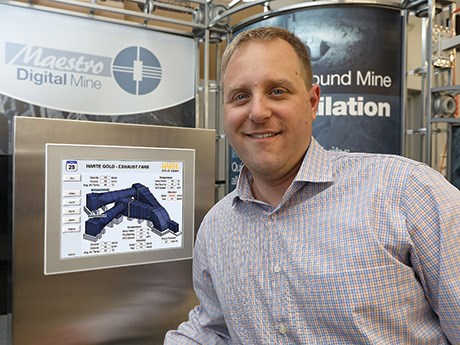Maestro Digital Mine has released a new product called FanMon that allows technicians to remotely dial into a ventilation fan to monitor its performance and diagnose problems.
“One of the challenges with ventilation fans is that there are very few mining companies with fan specialists on staff,” explained Michael Gribbons, Maestro’s vice-president of marketing and sales. “Vale and Glencore in Sudbury have them, but outside of these two companies, they don’t exist, so most mines need to have a third party fly in.”
FanMon tracks the performance metrics of main and booster fans ranging in size and power from 500 to 4,500 horsepower and is Ethernet enabled for remote communication, allowing a fan specialist in Toronto, for example, to monitor fan performance and diagnose a problem without the expense of a trip to a mine a thousand kilometres away.
The product includes a cabinet with an interactive screen that displays performance metrics locally. The system monitors each fan bearing (inner raceway, outer raceway and rolling elements) along with total fan imbalance, according to Maestro Digital Mine’s website, while the LED display shows airflow, air temperature, pressure and vibration levels.
In the event of a serious malfunction, FanMon automatically alerts the mine’s control room.
Competing technologies for large fans used in the mining industry are all analog based, said Gribbons. “They can’t get the data out.”
It may still be necessary for a technician to make a site visit to repair a fan, but FanMon will allow technicians to track a fan’s performance over time, anticipate an eventual failure and schedule preventive maintenance. The technician can also warn a mine of the need for an immediate repair to prevent a shutdown of operations.
“If you have to shut down a booster fan or a primary fan, you can shut down an entire level or an entire mine,” said Gribbons.
Fans currently in the field can be retrofitted to accommodate FanMon, but Maestro Digital Mine will focus primarily on sales to fan manufacturers, which will be able to integrate the technology on new fans. Engineering firms like Hatch and Stantec will also be pitched to spec FanMon for new installations.
With FanMon, manufacturers will also be able to sell service contracts for monitoring fans remotely.
Maestro Digital Mine has already closed sales to Torex Gold, Integra Gold, Harte Gold and Vale, said Gribbons.
The company is also having success with another recently launched product called Plexus PowerNet, a gigabit communication network providing both power and data using conventional coaxial cable.
To date, Maestro Digital Mine boasts 20 Plexus PowerNet installations and “has a lot of pokers in the fire,” said Gribbons.
READ: New solution offered for mine-wide networking
Plexus PowerNet enables digital communication without the need to bring in specialists to terminate fiber-optic cable.
Using standard co-ax cable with the Plexus PowerNet node simplifies the process. The node features colour coded LEDs, so mine electricians just need to read the lights and understand them.
“Vale, for example, was able to go 1,700 feet down a manway to a Maestro Digital Mine air quality monitoring station with no power down there. They were very pleased. Barrick bought three systems and we sold a mine-wide system consisting of 65 Plexus units and 17 power supplies to MATSA’s Magdalena copper mine in Huelva, Spain.
“It’s going exactly the way we thought it would,” said Gribbons. “I predicted we would triple our business this year and I think we’re right on target to do it.”



